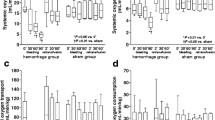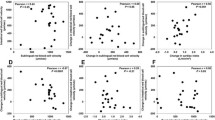Abstract
Objective
To compare systemic hemodynamics with microcirculatory changes at different vascular beds during progressive hemorrhage.
Setting
University-based research laboratory.
Subjects
Twelve anesthetized, mechanically ventilated sheep.
Interventions
Sheep were randomly assigned to HEMORRHAGE or CONTROL group. In the HEMORRHAGE group (n = 8), three stepwise bleedings of 5 ml/kg at 30-min intervals were performed to add up 15 ml/kg. In the CONTROL group (n = 4), sheep had the same surgical preparation but were not bled.
Measurements and main results
Progressive bleeding decreased cardiac output, and superior mesenteric artery blood flow, and systemic and intestinal oxygen transports from the first step of bleeding whereas systemic and intestinal oxygen consumption remained unchanged. Mean arterial blood pressure, arterial pH and base excess, and intramucosal-arterial PCO2 were only significantly modified in the last step of bleeding. Arterial lactate increased and sublingual, and intestinal serosal and mucosal capillary microvascular flow indexes and red blood cell velocities progressively decreased after the first step of bleeding (3.0 ± 0.1 vs. 2.3 ± 0.4, 3.2 ± 0.2 vs. 2.4 ± 0.6, 3.0 ± 0.0 vs. 2.0 ± 0.2, and 1,082 ± 29 vs. 977 ± 79, 1,042 ± 24 vs. 953 ± 60, 287 ± 65 vs. 262 ± 16 μm/s; P < 0.05 for all).
Conclusions
Alterations in sublingual, intestinal microcirculation, and arterial lactate simultaneously arose from the first step of bleeding. The microcirculatory changes were identified either by semi-quantitative flow index or by quantitative red blood cell velocity measurements.





Similar content being viewed by others
References
Crowell JW, Smith EE (1964) Oxygen deficit and irreversible hemorrhagic shock. Am J Physiol 206:313–316
Rivers E, Nguyen B, Havstad S, Ressler J, Muzzin A, Knoblich B, Peterson E, Tomlanovich M, Early Goal-Directed Therapy Collaborative Group (2001) Early goal-directed therapy in the treatment of severe sepsis and septic shock. N Engl J Med 345:1368–1377
Hamilton-Davies C, Mythen MG, Salmon JB, Jacobson D, Shukla A, Webb AR (1997) Comparison of commonly used clinical indicators of hypovolaemia with gastrointestinal tonometry. Intensive Care Med 23:276–281
Povoas HP, Weil MH, Tang W, Moran B, Kamohara T, Bisera J (2000) Comparisons between sublingual and gastric tonometry during hemorrhagic shock. Chest 118:1127–1132
Weil MH, Afifi AA (1970) Experimental and clinical studies on lactate and pyruvate as indicators of the severity of acute circulatory failure (shock). Circulation 41:989–1001
Davis JW, Shackford SR, Mackersie RC, Hoyt DB (1988) Base deficit as a guide to volume resuscitation. J Trauma 28:1464–1467
Sinaasappel M, van Iterson M, Ince C (1999) Microvascular oxygen pressure in the pig intestine during haemorrhagic shock and resuscitation. J Physiol 514:245–253
Fruchterman TM, Spain DA, Wilson MA, Harris PD, Garrison RN (1998) Complement inhibition prevents gut ischemia and endothelial cell dysfunction after hemorrhage/resuscitation. Surgery 124:782–791
Watkins JM, Spain DA, Krysztopik RJ, Downard PJ, Wilson MA, Garrison RN (1996) Heparan preserves intestinal perfusion after hemorrhage and resuscitation. J Surg Res 66:154–158
Zhao KS, Junker D, Delano FA, Zweifach BW (1985) Microvascular adjustments during irreversible hemorrhagic shock in rat skeletal muscle. Microvasc Res 30:143–153
Colantuoni A, Bertuglia S, Intaglietta M (1985) Microvessel diameter changes during hemorrhagic shock in unanesthetized hamsters. Microvasc Res 30:133–142
Morini S, Yacoub W, Rastellini C, Gaudio E, Watkins SC, Cicalese L (2000) Intestinal microvascular patterns during hemorrhagic shock. Dig Dis Sci 45:710–722
Fang X, Tang W, Sun S, Huang L, Chang YT, Castillo C, Weil MH (2006) Comparison of buccal microcirculation between septic and hemorrhagic shock. Crit Care Med 34:S447–S453
Balogh Z, Wolfárd A, Szalay L, Orosz E, Simonka JA, Boros M (2002) Dalteparin sodium treatment during resuscitation inhibits hemorrhagic shock-induced leukocyte rolling and adhesion in the mesenteric microcirculation. J Trauma 52:1062–1069
Kerger H, Waschke KF, Ackern KV, Tsai AG, Intaglietta M (1999) Systemic and microcirculatory effects of autologous whole blood resuscitation in severe hemorrhagic shock. Am J Physiol 276:H2035–H2043
Goedhart PT, Khalilzada M, Bezemer R, Merza J, Ince C (2007) Sidestream Dark Field (SDF) imaging: a novel stroboscopic LED ring-based imaging modality for clinical assessment of the microcirculation. Optics Express 15:15101–15114
De Backer D, Creteur J, Preiser JC, Dubois MJ, Vincent JL (2002) Microvascular blood flow is altered in patients with sepsis. Am J Respir Crit Care Med 166:98–104
Sakr Y, Dubois MJ, De Backer D, Creteur J, Vincent JL (2004) Persistent microcirculatory alterations are associated with organ failure and death in patients with septic shock. Crit Care Med 32:1825–1831
Boerma EC, Mathura KR, van der Voort PHJ, Spronk PE, Ince C (2005) Quantifying bedside-derived imaging of microcirculatory abnormalities in septic patients: a prospective validation study. Crit Care 9:R601–R606
Dubin A, Pozo MO, Ferrara G, Murias G, Martins E, Canullán C, Canales HS, Ince C (2006) Changes in microcirculation are early indicators of hypovolemia. Intensive Care Med 32:S81
Dobbe JG, Streekstra GJ, Atasever B, van Zijderveld R, Ince C (2008) Measurement of functional microcirculatory geometry and velocity distributions using automated image analysis. Med Biol Eng Comput 46:659–670
Trzeciak S, Dellinger RP, Parrillo JE, Guglielmi M, Bajaj J, Abate NL, Arnold RC, Colilla S, Zanotti S, Hollenberg SM, Microcirculatory Alterations in Resuscitation, Shock Investigators (2007) Early microcirculatory perfusion derangements in patients with severe sepsis and septic shock: relationship to hemodynamics, oxygen transport, and survival. Ann Emerg Med 49:88–98
De Backer D, Hollenberg S, Boerma C, Goedhart P, Büchele G, Ospina-Tascon G, Dobbe I, Ince C (2007) How to evaluate the microcirculation: report of a round table conference. Crit Care 11:R101
Torrington KG, McNeil JS, Phillips YY, Ripple GR (1989) Blood volume determinations in sheep before and after splenectomy. Lab Anim Sci 39:598–602
American College of Surgeons, Committee on Trauma: advanced trauma life support for doctors course manual (1997), 6th edn. Chicago
Schadt JC, Ludbrook J (1991) Hemodynamic and neurohumoral responses to acute hypovolemia in conscious mammals. Am J Physiol 260:H305–H318
Boerma EC, van der Voort PH, Spronk PE, Ince C (2007) Relationship between sublingual and intestinal microcirculatory perfusion in patients with abdominal sepsis. Crit Care Med 35:1055–1060
Dubin A, Edul VS, Pozo MO, Murias G, Canullán CM, Martins EF, Ferrara G, Canales HS, Laporte M, Estenssoro E, Ince C (2008) Persistent villi hypoperfusion explains intramucosal acidosis in sheep endotoxemia. Crit Care Med 36:535–542
Deruddre S, Pottecher J, Georger J, Repéssé X, Benhamou D, Vicaut E, Teboul J, Duranteau J (2007) Sublingual microcirculatory improvement with fluid loading in preload-dependent ICU patients. Intensive Care Med 33:S253
Vajda K, Szabó A, Boros M (2004) Heterogeneous microcirculation in the rat small intestine during hemorrhagic shock: quantification of the effects of hypertonic–hyperoncotic resuscitation. Eur Surg Res 36:338–344
Nakajima Y, Baudry N, Duranteau J, Vicaut E (2001) Microcirculation in intestinal villi: a comparison between hemorrhagic and endotoxin shock. Am J Respir Crit Care Med 164:1526–1530
Zakaria el R, Garrison RN, Spain DA, Matheson PJ, Harris PD, Richardson JD (2003) Intraperitoneal resuscitation improves intestinal blood flow following hemorrhagic shock. Ann Surg 237:704–711
Bracht H, Krejci V, Hiltebrand LB, Brandt S, Sigurdsson G, Ali SZ, Takala J, Jakob SM (2008) Orthogonal polarization spectroscopy to detect mesenteric hypoperfusion. Intensive Care Med 34:1883–1890
Ince C (2008) The elusive microcirculation. Intensive Care Med 34:1755–1756
Boerma EC, Kuiper MA, Kingma WP, Egbers PH, Gerritsen RT, Ince C (2008) Disparity between skin perfusion and sublingual microcirculatory alterations in severe sepsis and septic shock: a prospective observational study. Intensive Care Med 34:1294–1298
Dubin A, Estenssoro E, Murias G, Canales H, Sottile P, Badie J, Baran M, Palizas F, Laporte M, Rivas Diaz M (2001) Effects of hemorrhage on gastrointestinal oxygenation. Intensive Care Med 27:1931–1936
Knichwitz G, Rotker J, Mollhoff T, Richter KD, Brussel T (1998) Continuous intramucosal PCO2 measurement allows the early detection of intestinal malperfusion. Crit Care Med 26:1550–1557
McCarter FD, James JH, Luchette FA, Wang L, Friend LA, King JK, Evans JM, George MA, Fischer JE (2001) Adrenergic blockade reduces skeletal muscle glycolysis and Na(+), K(+)-ATPase activity during hemorrhage. J Surg Res 99:235–244
Conflict of interest statement
Dr. Ince is Chief Scientific Officer of MicroVision Medical (an university-based company manufacturing sidestream dark-field devices) and holds patents and stock related to sidestream dark-field imaging. The remaining authors have not disclosed any potential conflicts of interest.
Author information
Authors and Affiliations
Corresponding author
Additional information
This article is discussed in the editorial available at: doi:10.1007/s00134-008-1386-z
Electronic supplementary material
Below is the link to the electronic supplementary material.
Supplementary material 2 (WMV 4.65 MB)
Rights and permissions
About this article
Cite this article
Dubin, A., Pozo, M.O., Ferrara, G. et al. Systemic and microcirculatory responses to progressive hemorrhage. Intensive Care Med 35, 556–564 (2009). https://doi.org/10.1007/s00134-008-1385-0
Received:
Accepted:
Published:
Issue Date:
DOI: https://doi.org/10.1007/s00134-008-1385-0




